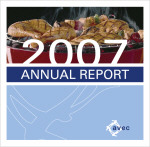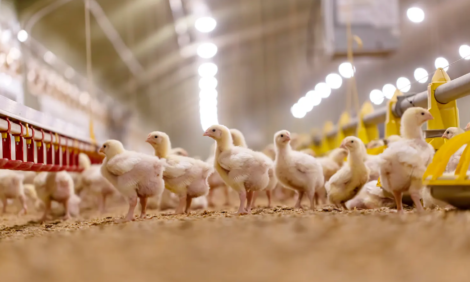



Chicken Welfare: From The Farm...To The Slaughterhouse
This feature is taken from the Avec Annual Report for 2007. A link to the full report is also provided. Poultry welfare is one of the major challenges for the European poultry industry.
To ensure the health and productivity of their flocks, poultry producers should continue to employ the "best management" practices recommended by equipment manufacturers, breeders, trade organizations, and scientists. There is a growing concern within civil society about the welfare of animals, reinforcing the need for the industry to consider the behavioral needs of animals. At European level, action plans and directives are adopted.The European poultry industry is one of the most integrated meat production chains, therefore all operators in the chain have more or less to insure poultry welfare at the different stages, i.e. at the farm, during transport and at slaughter.
Protection at the farm: a new directive
In this matter, 2007 has been most productive, and especially the German presidency of the European Council, in adopting the Council Directive laying down minimum rules for the protection of chickens kept for meat production. Suspended during the AI crisis in the spring 2006, the Directive proposed by the Commission in March 2005, has been back on the table during the Finnish presidency in 2006 and has been adopted during the German Presidency in June 2007.The objective of this proposal is to avoid competition distorting differences and assure a smooth running of the organization of the common market in chicken meat while proposing common standards for the protection of chickens kept for meat production.
AVEC has been very active in the procedure and managed to have an acceptable compromise for the European Poultry industry. Member States will have to implement the Directive by 2010. This one introduces the following:
- a maximum stocking density of 33 kg/m², with derogations allowing under certain conditions a maximum of 39 kg/m², and 42 kg/m² where prevailing conditions result in a low mortality rate;
- rules concerning the development of good practices guides at national /European level, the training of farmers dealing with chickens kept for meat production, and also as for animals' drinking facilities, feeding, litter, ventilation, heating, noise, light, cleanliness and surgical interventions;
- several reports to be made by the Commission: before 30 June 2009, a report on the possible introduction of a specific harmonised mandatory labelling scheme for chicken meat, before 31 December 2010, a report on the influence of genetic parameters on identified deficiencies resulting in poor welfare of chickens and before 30 June 2012, a report concerning the application of the Directive and the development of welfare indicators
Transportation: application of the new regulation
The transportation of animals is an important issue. It is covered by Council Regulation (EC) 1/2005 on the protection of animals during transport and related operations which had to be apply as from 5 January 2007. It helps to safeguard animal welfare by radically improving the enforcement of animal transport rules in the EU.This regulation doesn’t cover only poultry but it identifies the chain of all those involved in animal transport, defining "who is responsible for what" thus facilitating more effective enforcement of the new rules. It introduced new, more efficient monitoring tools and much stricter rules for journeys of more than 8 hours, including a substantial upgrading of vehicle standards. The satellite navigation systems became obligatory in road vehicles transporting livestock over 8 hours and transporters have now to be approved while drivers have to be skilled. Currently the Commission is working on the creation of a harmonised system within the Community. avec is not directly involved but keeps an eye on the possible consequences for the industry.
Revision of the directive on protection at the slaughterhouse
On this matter, EU legislation aims to minimise the pain and suffering of animals through the use of properly approved stunning and killing methods, based on scientific knowledge and practical experience. The first Council Directive 74/577/EC on stunning animals before slaughter was replaced in 1993 with Council Directive 93/119/EEC on the protection of animals at the time of slaughter or killing, covering a wider range of animals and slaughter circumstances. In 2004 and 2006 the European Food Safety Authority (EFSA) adopted two Opinions on stunning and killing methods. 14 Chickens and turkeys are covered in the 2004 opinion in which mechanical, electrical and gas stunning / killing methods have been studied while in opinion of 2006 ducks, geese and quail are included.The Commission is now working on a revision of the current legislation to reflect new knowledge and advanced scientific evidence and to further reduce the suffering of animals.
This year avec and its members have been in contact with DG SANCO several times on this matter. Before submitting its proposal to the Council and the European Parliament, the Commission is carrying out preparatory work in four fields: technical field (collecting scientific information and technical data), legal field (defining legal instruments and viable implementation by operators; facilitating proper monitoring by competent authorities), economic field (evaluating the impacts of the major options to be considered on the economic viability of the sectors) and social field (collecting opinions and positions from the major stakeholders, including avec and its members).The process of evaluation in the economic field has been carried out by an independent consultant, the Food Chain Evaluation Consortium (FCEC), under a framework contract with DG SANCO. The study into stunning/killing practices in slaughterhouses and their economic, social and environmental consequences, launched by the Commission on 1 July 2006, has been completed in July 2007. Results are waited.
Labelling of animal welfare
Planned in the first draft of the Council directive on the protection of chickens kept for meat production but removed, the labelling of animal welfare is a major interest for the poultry industry as it could become mandatory in the coming years. The obvious aim is to improve animal welfare but this has to be done in establishing a labelling system that is easy to understand for consumers and does not create new bureaucratic burdens. Indeed in March 2007, the German Council Presidency, in cooperation with the European Economic and Social Committee and the EU Commission organised a conference on the labelling of animal welfare where avec participated. Constructive discussions between operators in the food chain, consumer and animal welfare associations and representatives of the scientific community and authorities suggested that there may be possibilities, both within the internal market but also at international level, to improve animal welfare by labelling products of animal origin according to the respective husbandry system in which the animals have been reared.The prerequisite for this are uniform criteria which are to be established, including defining welfare indicators. Some believe that all the actors of the food chain could profit from EU animal welfare labelling: farmers (also by better price), food industry (product differentiation), retailers (fulfilling demand of consumers), consumers (can make a real choice) and animals (improved animal welfare). Nevertheless, avec is not in favor of a specific animal welfare label but advocates that animal welfare is just one of a number of social objective that has to be taken into account in the overall production chain.
Animal welfare worldwide
At international level, animal welfare has taken much greater importance in recent years. The Commission has been developing animal welfare legislation for over 30 years and has been at the forefront of initiatives to promote it internationally by its active participation in, and support for, initiatives of the Council of Europe.
- In 1988 the Community ratified the Council of Europe Convention for the Protection of Animals Kept for Farming Purposes and recommendations on the protection of duck and geese and of fur animals entered into force. In 1998 the Community adopted a decision to approve the Council of Europe Convention for the Protection of Animals for Slaughter (the formal ratification process is not completed yet) and in June 2003 the Council of Europe's Committee of Ministers adopted the revised Council of Europe Convention for the Protection of Animals during International Transport (that EU signed in June 2004).
- Furthermore, the World Organisation for Animal Health (OIE) created in 2004 the World Health and Welfare Fund to help developing countries meet international standards for dealing with disease outbreaks, animal welfare and related issues. Lately in 2005 the OIE adopted guidelines on stunning and killing for human consumption as well as on killing for disease-control purposes.
- As for the World Trade Organisation (WTO), the Commission has undertaken to raise the issue of animal welfare in the new WTO negotiating round. However, during the negotiations in Seattle in 1999 there was no support for the approach as proposed by the Community. The Commission continued nonetheless to work towards international acceptance of animal welfare concerns during the WTO ministerial conference in Doha in November 2001.
In conclusion, the poultry industry is the largest (in terms of animal numbers) and the most highly automated, vertically integrated, and intensified of the animal production industries.As a consequence, there has been a great deal of public interest in the welfare of poultry. Thus the European Poultry Industry has to keep in mind that their interest in being active and proactive in the field of animal welfare is one of the key factors for its development and its positive image with consumers.
Current European legislation on animal welfare |
||
| Legislation | Topic | |
| General overview | Commission working document of 23 January 2006 | Community action plan for protection and welfare of animals 2006-2010 |
| Laying Hens | Council Directive 88/166/EEC | Minimum standards for the protection of laying hens kept in battery cages |
| Council Directive 1999/74/EC | Minimum standards for the protection of laying hens | |
| Commission Directive 2002/4/EC | Registration of establishments keeping laying hens | |
| Commission proposal of 30 May 2005 | Proposal for a Council Directive laying down minimum rules for the protection of chickens kept for meat production | |
| Protection during transport | Council Directive 91/628/EEC | Protection of animals during transport (amending Directives 90/425/EEC and 91/496/EEC) |
| Council Directive 95/29/EC | Protection of animals during transport | |
| Council Regulation (EC) 1255/97 | Community criteria for staging points and amending the route plan referred to in Annex to Directive 91/628/EEC | |
| Council Regulation (EC) 411/98 | Aditional animal protection standards applicable to road vehicles used for the carriage of livestock on journeys exceeding eight hours | |
| Commission Decision 2001/298/EEC | Protection of animals during transport (as regards veterinary certificates for intra- Community trade of livestock) | |
| Council Regulation (EC) 1040/2003 | Amending Regulation (EC) No 1255/97 as regards the use of staging points | |
| Council Decision 2004/544/EC | European Convention for the protection of animals during International Transport | |
| Council Regulation (EC) 1/2005 | Protection of animals during transport and related operations (amending Directives 64/432/EEC and 93/119/EC and Regulation (EC) No 1255/97) | |
| Protection at the time of slaughter and killing | Council Decision 88/306/EEC | European Convention for the protection of animals for slaughter |
| Council Directive 93/119/EC | Protection of animals at the time of slaughter or killing (under revision) | |
Further Reading
|
|
Take a look at Avec's Annual Report for 2007 by clicking here. |
|
|
You can view the press release that coincided with this report by clicking here. |
November 2007








